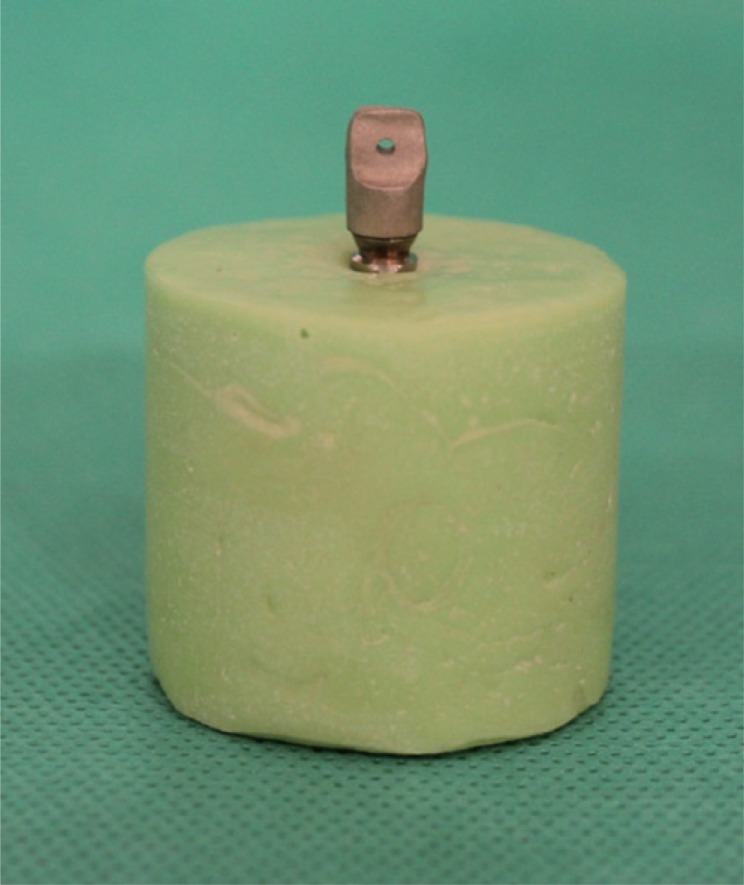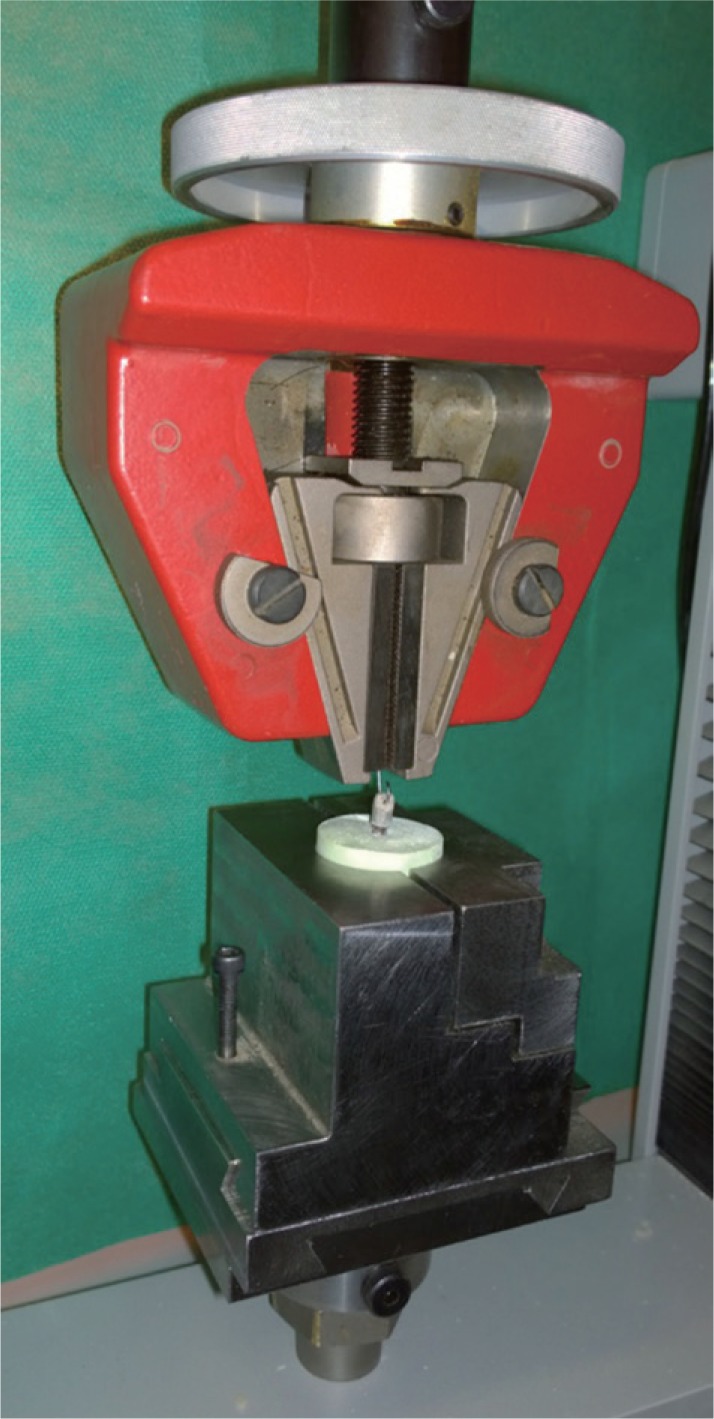J Adv Prosthodont.
2018 Feb;10(1):1-7. 10.4047/jap.2018.10.1.1.
Effects of abutment diameter, luting agent type, and re-cementation on the retention of implant-supported CAD/CAM metal copings over short abutments
- Affiliations
-
- 1Department of Prosthodontics, College of Dentistry, Kerman University of Medical Sciences, Kerman, Iran. fereshteh.hoseini7@gmail.com
- KMID: 2403992
- DOI: http://doi.org/10.4047/jap.2018.10.1.1
Abstract
- PURPOSE
The aim of this study was to evaluate the effects of abutment diameter, cement type, and re-cementation on the retention of implant-supported CAD/CAM metal copings over short abutments.
MATERIALS AND METHODS
Sixty abutments with two different diameters, the height of which was reduced to 3 mm, were vertically mounted in acrylic resin blocks with matching implant analogues. The specimens were divided into 2 diameter groups: 4.5 mm and 5.5 mm (n=30). For each abutment a CAD/CAM metal coping was manufactured, with an occlusal loop. Each group was sub-divided into 3 sub-groups (n=10). In each subgroup, a different cement type was used: resin-modified glass-ionomer, resin cement and zinc-oxide-eugenol. After incubation and thermocycling, the removal force was measured using a universal testing machine at a cross-head speed of 0.5 mm/min. In zinc-oxide-eugenol group, after removal of the coping, the cement remnants were completely cleaned and the copings were re-cemented with resin cement and re-tested. Two-way ANOVA, post hoc Tukey tests, and paired t-test were used to analyze data (α=.05).
RESULTS
The highest pulling force was registered in the resin cement group (414.8 N), followed by the re-cementation group (380.5 N). Increasing the diameter improved the retention significantly (P=.006). The difference in retention between the cemented and recemented copings was not statistically significant (P=.40).
CONCLUSION
Resin cement provided retention almost twice as strong as that of the RMGI. Increasing the abutment diameter improved retention significantly. Re-cementation with resin cement did not exhibit any difference from the initial cementation with resin cement.
Keyword
Figure
Cited by 2 articles
-
Influence of abutment height and convergence angle on the retrievability of cement-retained implant prostheses with a lingual slot
Kyu-Hyung Choi, KeunBaDa Son, Du-Hyeong Lee, Kyu-Bok Lee
J Adv Prosthodont. 2018;10(5):381-387. doi: 10.4047/jap.2018.10.5.381.Influence of varying cement types and abutment heights on pull-off force of zirconia restorations
Yeong-Jun Jung, Yu-Lee Kim, Ji-Hye Jung, Nae-Un Kang, Hyun-Jun Kong
J Dent Rehabil Appl Sci. 2024;40(2):64-71. doi: 10.14368/jdras.2024.40.2.64.
Reference
-
1. Abbo B, Razzoog ME, Vivas J, Sierraalta M. Resistance to dislodgement of zirconia copings cemented onto titanium abutments of different heights. J Prosthet Dent. 2008; 99:25–29. PMID: 18182182.
Article2. Mish CE. Dental implant prosthetics. 2th ed. St. Louis: Elsevier Co.;2015. p. 21–22.3. Hebel KS, Gajjar RC. Cement-retained versus screw-retained implant restorations: achieving optimal occlusion and esthetics in implant dentistry. J Prosthet Dent. 1997; 77:28–35. PMID: 9029462.
Article4. Chee WW, Torbati A, Albouy JP. Retrievable cemented implant restorations. J Prosthodont. 1998; 7:120–125. PMID: 9743667.
Article5. Chee W, Felton DA, Johnson PF, Sullivan DY. Cemented versus screw-retained implant prostheses: which is better? Int J Oral Maxillofac Implants. 1999; 14:137–141. PMID: 10074764.6. Güncü MB, Cakan U, Canay S. Comparison of 3 luting agents on retention of implant-supported crowns on 2 different abutments. Implant Dent. 2011; 20:349–353. PMID: 21811170.
Article7. Akça K, Iplikçioğlu H, Cehreli MC. Comparison of uniaxial resistance forces of cements used with implant-supported crowns. Int J Oral Maxillofac Implants. 2002; 17:536–542. PMID: 12182296.8. Bresciano M, Schierano G, Manzella C, Screti A, Bignardi C, Preti G. Retention of luting agents on implant abutments of different height and taper. Clin Oral Implants Res. 2005; 16:594–598. PMID: 16164467.
Article9. Kim Y, Yamashita J, Shotwell JL, Chong KH, Wang HL. The comparison of provisional luting agents and abutment surface roughness on the retention of provisional implant-supported crowns. J Prosthet Dent. 2006; 95:450–455. PMID: 16765158.
Article10. Akin H, Guney U. Effect of various surface treatments on the retention properties of titanium to implant restorative cement. Lasers Med Sci. 2012; 27:1183–1187. PMID: 22124579.
Article11. Qeblawi DM, Muñoz CA, Brewer JD, Monaco EA Jr. The effect of zirconia surface treatment on flexural strength and shear bond strength to a resin cement. J Prosthet Dent. 2010; 103:210–220. PMID: 20362764.
Article12. Kent DK, Koka S, Froeschle ML. Retention of cemented implant-supported restorations. J Prosthodont. 1997; 6:193–196. PMID: 9497775.
Article13. Pan YH, Lin TM, Liu PR, Ramp LC. Effect of luting agents on retention of dental implant-supported prostheses. J Oral Implantol. 2015; 41:596–599. PMID: 24666355.
Article14. Michalakis KX, Hirayama H, Garefis PD. Cement-retained versus screw-retained implant restorations: a critical review. Int J Oral Maxillofac Implants. 2003; 18:719–728. PMID: 14579961.15. Sahu N, Lakshmi N, Azhagarasan NS, Agnihotri Y, Rajan M, Hariharan R. Comparison of the effect of implant abutment surface modifications on retention of implant-supported restoration with a polymer based cement. J Clin Diagn Res. 2014; 8:239–242.16. Michalakis K, Pissiotis AL, Kang K, Hirayama H, Garefis PD, Petridis H. The effect of thermal cycling and air abrasion on cement failure loads of 4 provisional luting agents used for the cementation of implant-supported fixed partial dentures. Int J Oral Maxillofac Implants. 2007; 22:569–574. PMID: 17929517.17. Lee DH, Lee BJ, Kim SH, Lee KB. Shear bond strength of porcelain to a new millable alloy and a conventional castable alloy. J Prosthet Dent. 2015; 113:329–335. PMID: 25681353.
Article18. Lee JH. An accelerated technique for a ceramic-pressed-tometal restoration with CAD/CAM technology. J Prosthet Dent. 2014; 112:1021–1023. PMID: 24952883.
Article19. Suleiman SH, Vult von. Fracture strength of porcelain fused to metal crowns made of cast, milled or laser-sintered cobalt-chromium. Acta Odontol Scand. 2013; 71:1280–1289. PMID: 23320554.20. Kim KB, Kim JH, Kim WC, Kim JH. Three-dimensional evaluation of gaps associated with fixed dental prostheses fabricated with new technologies. J Prosthet Dent. 2014; 112:1432–1436. PMID: 25218032.
Article21. Rödiger M, Rinke S, Ehret-Kleinau F, Pohlmeyer F, Lange K, Bürgers R, Gersdorff N. Evaluation of removal forces of implant-supported zirconia copings depending on abutment geometry, luting agent and cleaning method during re-cementation. J Adv Prosthodont. 2014; 6:233–240. PMID: 25006388.
Article22. Farzin M, Torabi K, Ahangari AH, Derafshi R. Effect of abutment modification and cement type on retention of cement-retained implant supported crowns. J Dent (Tehran). 2014; 11:256–262. PMID: 25628660.23. Ayad MF, Rosenstiel SF, Woelfel JB. The effect of recementation on crown retention. Int J Prosthodont. 1998; 11:177–182. PMID: 9709609.24. Felton DA, Kanoy BE, White JT. Recementation of dental castings with zinc phosphate cement: effect on cement bond strength. J Prosthet Dent. 1987; 58:579–583. PMID: 3316604.
Article25. Ayad MF, Johnston WM, Rosenstiel SF. Influence of tooth preparation taper and cement type on recementation strength of complete metal crowns. J Prosthet Dent. 2009; 102:354–361. PMID: 19961993.
Article26. Cano-Batalla J, Soliva-Garriga J, Campillo-Funollet M, Munoz-Viveros CA, Giner-Tarrida L. Influence of abutment height and surface roughness on in vitro retention of three luting agents. Int J Oral Maxillofac Implants. 2012; 27:36–41. PMID: 22299076.27. Carnaggio TV, Conrad R, Engelmeier RL, Gerngross P, Paravina R, Perezous L, Powers JM. Retention of CAD/CAM all-ceramic crowns on prefabricated implant abutments: an in vitro comparative study of luting agents and abutment surface area. J Prosthodont. 2012; 21:523–528. PMID: 22469271.
Article28. Covey DA, Kent DK, St Germain, Koka S. Effects of abutment size and luting cement type on the uniaxial retention force of implant-supported crowns. J Prosthet Dent. 2000; 83:344–348. PMID: 10709044.
Article29. Nejatidanesh F, Savabi O, Ebrahimi M, Savabi G. Retentiveness of implant-supported metal copings using different luting agents. Dent Res J (Isfahan). 2012; 9:13–18. PMID: 22363357.30. Nejatidanesh F, Savabi O, Jabbari E. Effect of surface treatment on the retention of implant-supported zirconia restorations over short abutments. J Prosthet Dent. 2014; 112:38–44. PMID: 24388717.
Article31. Sadig WM, Al Harbi MW. Effects of surface conditioning on the retentiveness of titanium crowns over short implant abutments. Implant Dent. 2007; 16:387–396. PMID: 18091167.
Article32. White SN, Yu Z. Film thickness of new adhesive luting agents. J Prosthet Dent. 1992; 67:782–785. PMID: 1328622.
Article33. Bernal G, Okamura M, Muñoz CA. The effects of abutment taper, length and cement type on resistance to dislodgement of cement-retained, implant-supported restorations. J Prosthodont. 2003; 12:111–115. PMID: 12964683.
Article34. Pinelli LA, Fais LM, Ricci WA, Reis JM. In vitro comparisons of casting retention on implant abutments among commercially available and experimental castor oil-containing dental luting agents. J Prosthet Dent. 2013; 109:319–324. PMID: 23684282.
Article35. Kokubo Y, Kano T, Tsumita M, Sakurai S, Itayama A, Fukushima S. Retention of zirconia copings on zirconia implant abutments cemented with provisional luting agents. J Oral Rehabil. 2010; 37:48–53. PMID: 19849775.
Article36. Pan YH, Ramp LC, Lin CK, Liu PR. Comparison of 7 luting protocols and their effect on the retention and marginal leakage of a cement-retained dental implant restoration. Int J Oral Maxillofac Implants. 2006; 21:587–592. PMID: 16955610.37. Rappelli G, Corso M, Coccia E, Camaioni E, Di Felice R, Procaccini M. In vitro retentive strength of metal superstructures cemented to solid abutments. Minerva Stomatol. 2008; 57:95–101. PMID: 18427377.38. Garg P, Pujari ML, Prithviraj R, Khare S. Retentiveness of various luting agents used with implant-supported prosthesis: An in vitro study. J Oral Implantol. 2014; 40:649–654. PMID: 25506659.
Article39. Ebert A, Hedderich J, Kern M. Retention of zirconia ceramic copings bonded to titanium abutments. Int J Oral Maxillofac Implants. 2007; 22:921–927. PMID: 18271373.
- Full Text Links
- Actions
-
Cited
- CITED
-
- Close
- Share
- Similar articles
-
- Evaluation of removal forces of implant-supported zirconia copings depending on abutment geometry, luting agent and cleaning method during re-cementation
- Considerations for Fabrication of CAD-CAM Abutments: Part I. Selection of Titanium Block and Fabrication Process
- A study on the complete retrieval system of the cementation type implant abutment
- Effect of cement type, luting protocol, and ceramic abutment material on the shade of cemented titanium-based lithium disilicate crowns and surrounding peri-implant soft tissue: a spectrophotometric analysis
- Study of screw loosening in cementation type implant abutment







